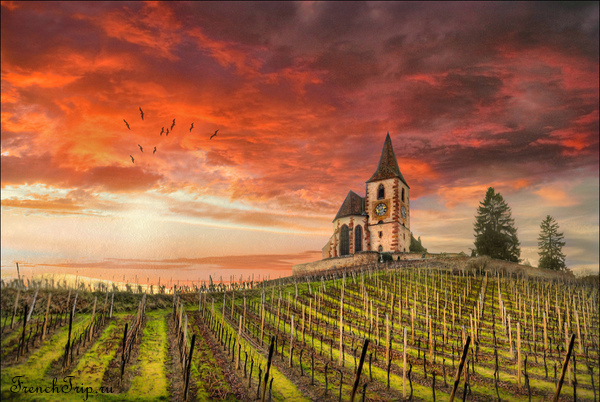Worldwide recognition of the variety
The historical name of the variety is Prince Jardinier, Meilland, France, 2009. "Le Prince Jardinier" - is translated from French as "prince-gardener" and belongs, as a playful nickname, to the heir to the famous aristocratic French dynasty, Louis Albert de Broglie.
In Russia and in the countries of the post-Soviet space, the variety got its second name, Alexander Pushkin. Is it because the great Russian poet loved roses and poetry just as much as Albert de Broglie, a poet who became a gardener, or a gardener who never ceased to hear poetry in every petal.
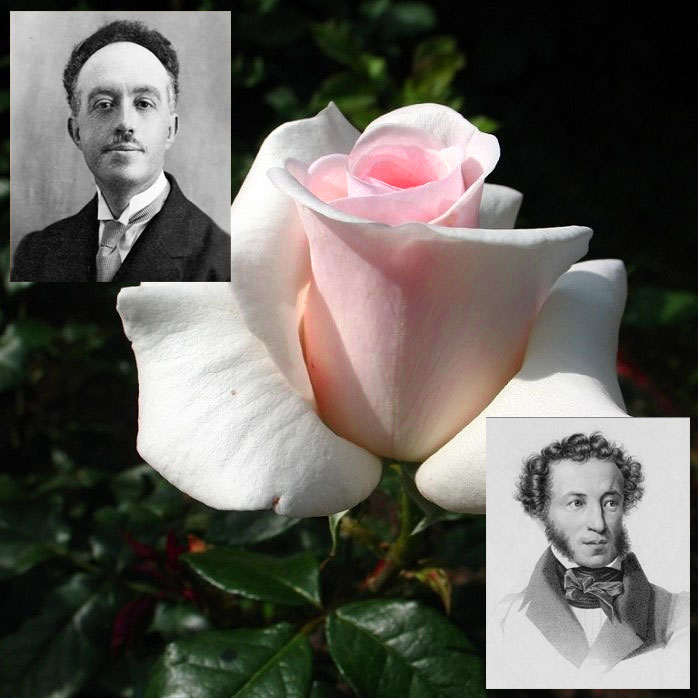
The variety's awards are simply impressive:
- silver medal of the competition of roses Baden-Baden (Germany), 2006,
- Prize for the fragrance of the Buenos Aires Rose Competition (Argentina), 2006,
- silver medal of the RELX Rose Competition (Belgium), 2006,
- Henry Edland Medal for Fragrance and Test Certificate of the Royal National Rose Society of Great Britain RNRS, 2007,
- second international prize of the city of Nantes (France), 2007,
- honorary diploma of the Rose Competition in Hradec Kralove (Czech Republic), 2007,
- ADR (Germany), 2008, titles "Crystal Rose" and "Public Choice" of the Orleans Rose Competition (France), 2008,
- the title of "Gold Standard" tests of the National Institute of Agricultural Botany of Great Britain NIAB and the British Rose Breeders Association, 2009,
- Certificate of honor of the Belfast Rose Competition (Ireland, UK), 2009,
- Prize for the fragrance of the Rose Competition The Hague (Netherlands), 2010,
- bronze certificate of the Hague Rose Competition (Netherlands), 2011,
- bronze medal of the Nagasaki Rose Competition (Japan), 2011.
The most awarded rose of its generation! She was chosen as a favorite to commemorate the centenary of the birth of Francis Mayland, an iconic figure in the modern rose-growing world.
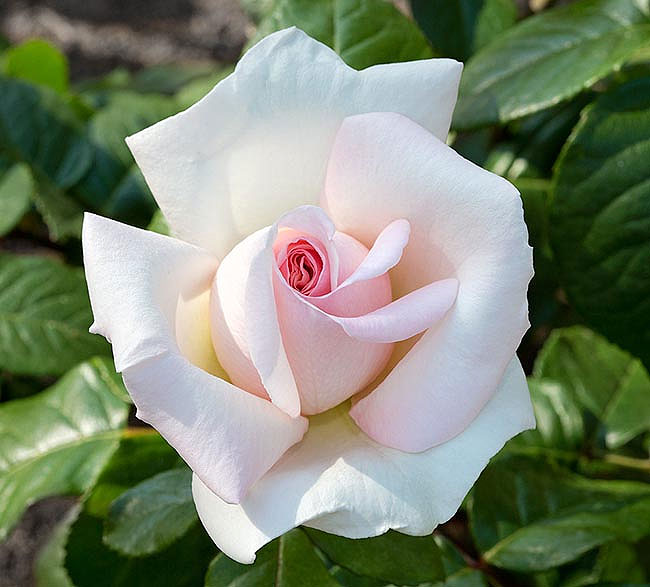
Description of the variety
The variety was bred by Alain Meiland in France, in 1996. Introduced in France by Meilland International in 2006 as Schloss Ippenburg.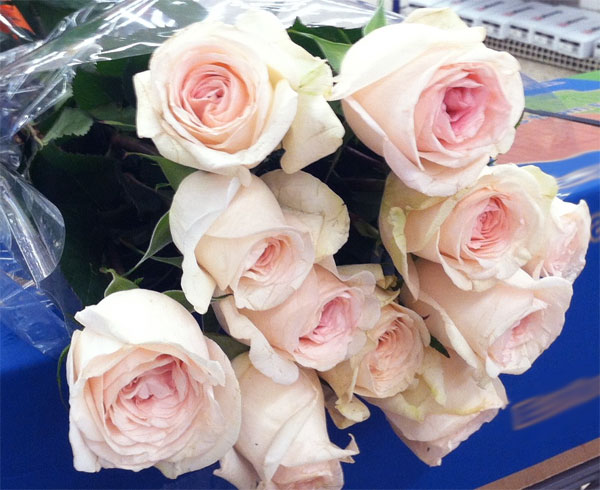
- Classification: tea hybrid.
- Petals color: white, pink in the center.
- Aroma: strong, citrusy, fruity, old rose scent.
- Bud from 37 petals. Average diameter 5 inches. The flower shape at the beginning of the dissolution is a glass, in full dissolution - a bowl.
- The foliage is large, glossy, dark green.
- Well leafy long shoots.
- The height of the bush is from 80 to 215 cm.
- USDA Zone 6b through 9b (default).
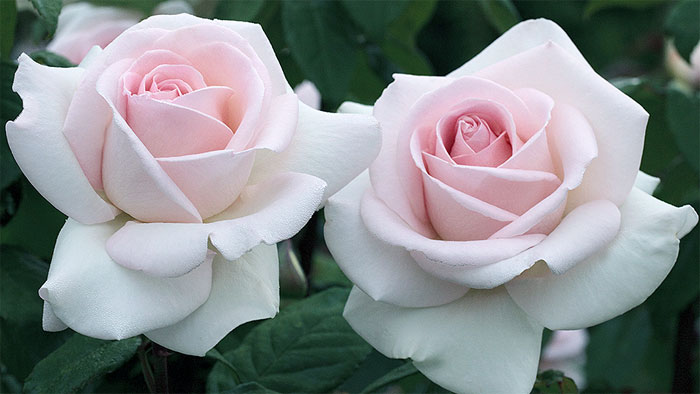
Agrotechnical features
The variety is characterized by fast growth and quick return. Blooms in the year of planting.
Frost resistance - above average. Resistance to powdery mildew is high, practically not affected by diseases and pests characteristic of other varieties.
Undemanding to the soil. The buds do not droop from the rain. Recommended to be planted in sunny flower beds or in partial shade.
Dominant role of green
Despite the fact that the French style is romantic, festive, solemnly sublime, bringing everything to the ideal, this is practically not displayed in the color palette. The main color of any French garden was and remains green. Tidy mowed lawns and all kinds of topiary art create frames and backgrounds to play with geometry and symmetry.
Green tunnels connecting flower beds, lawns, framing trimmed boxwood borders, trimmed hedges made of privet or yew along the perimeter of the site, a facade or screens entwined with green vines, numerous topiary - spheres, pyramids, etc. - should become dominant in the design of the garden.
When choosing woody ones, give preference to dark crowns, rather than extravagant and bright colors - plants that can replace cypresses and palms, if not in silhouette, then at least in color. Perfectly cope with the task, for example, a magnificent columnar juniper. You should not be afraid of monotony: the color in this style is used so pointwise that it literally shines on a green background and transforms everything.
Patterned parterres
Perhaps parterres are the most famous of the French-style decoration methods.Symmetrical, formal, surrounded by low trimmed borders and folding into an intricate hermetic figure or pattern, flower beds filled with low, ornamental flowers, trimmed green sculptures or decorative fillings - this is the hallmark of the French garden, which first comes to mind at any mention of the legendary Versailles or any other park ensembles.
But one should not think that the parterre is a palace luxury. You can also recreate them on your site. Playing with borders and plants, and even replacing full-fledged figures from flower beds with patterns inside carpet mixborders, inspired by ornaments, carpet motifs and even embroidery, you can recreate ornate French classics even in a small area.
The most popular varieties of French roses
Among the many varieties of this amazing flower, there are several varieties that are loved by gardeners all over the world.
The most popular among gardeners is the French rose named after the French cardinal Richelieu. The French rose variety Cardinal de Richelieu is represented by deep purple double petals. A very interesting fact of this rose is that when it just starts to open its buds, they have a pale pink color.
And when, all the petals open, they become lilac, and then almost purple. In addition, there are almost no thorns on the stem of the flower and the leaves have a very rich green color. Due to its extraordinary beauty and undemanding care, this variety of roses does not like direct sunlight. Therefore, the plant must be planted in an area where the sun will not fall on its petals in the midday heat;
No less popular is the French rose variety Charles de Mills, which was bred by Danish breeders. This rose belongs to the bush varieties and fell in love with its unusually beautiful and large flowers. And besides, they have an incredibly tasty aroma.
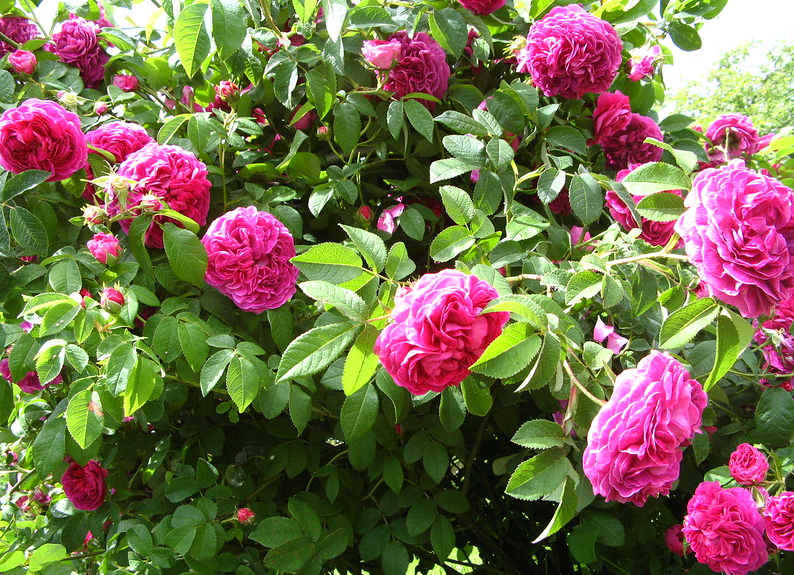
The main feature of this shrub is that it is not only hardy, but practically does not undergo all sorts of diseases. It can also tolerate planting in shady areas well. The flowering of this variety consists in a long and abundant flowering, but only once a year, and the buds themselves are collected in inflorescences of 3-5 roses;
The French rose Gallica Versicolor fell in love with gardeners for its amazing color, which is represented by a pale pink color with crimson stripes all over the petal. This variety of roses is not demanding to care for, it is quite frost-hardy, and has a pleasant aroma.
But it has one drawback, the bush of this variety is very easily susceptible to powdery mildew disease. To avoid this, it is necessary to carry out timely prevention by spraying the plant with special preparations.
How to distinguish
French roses grow in small bushes and have raised branches and shoots. This is how almost all varieties of these roses look. There are a lot of thorns on their shoots, which makes pruning difficult. Flowering shrubs lasts about 2-3 weeks: from mid-June to July. But you will experience real pleasure if you are near during their flowering period. It is simply a mesmerizing beauty that will not leave anyone indifferent.
Among French roses, you can find double and semi-double varieties. They had a rather unique color scheme for the period in which they appeared. These are carmine reds and purples. Not many older varieties can boast of similar colors. They also have a special aroma, which is tender, but at the same time is strong enough.
The oldest variety, Rosa galica, is a wild-growing garden rose. In the Middle Ages, its petals were dried and added to tea, or simply enjoyed their aroma in winter. In height, it reaches no more than one and a half meters.In the fall, in place of carmine-red semi-double inflorescences, bright red berries appear, somewhat reminiscent of a modern wild rose.
In addition to the aforementioned rose, among the French varieties of roses, there are several more, each of which has its own aroma and appearance. One variety was named after Cardinal Richelieu, while the other was mentioned as early as 1596 (Tuscany). Each of them is unique and beautiful in its own way.

Lavender
Lavender fields in Provence in France are already legendary. Hectares of these flowers are grown in the fields of several villages in the north of the country. Where else can you find the Lavender Museum or a variety of guided tours of the lavender fields? To see this beauty, experts advise to come here in June-July. Pregnant women are advised to inhale the scent of these endless fragrant fields, as well as to calm their nerves and gain peace of mind.
French lavender is interesting for its green spear-like shoots. At the end of each twig, 6 to 10 purple buds appear, which are used to make essential oils, soaps, cookies, muffins, and for medicinal purposes.
 |
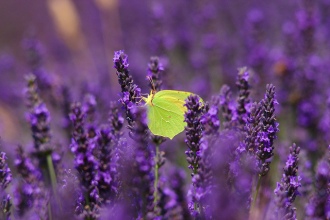 |
|
Legendary lavender cookie |
Lavender in bloom |
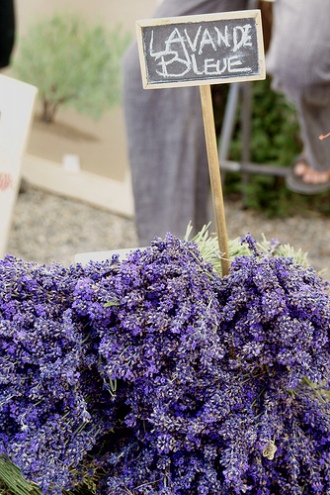 |
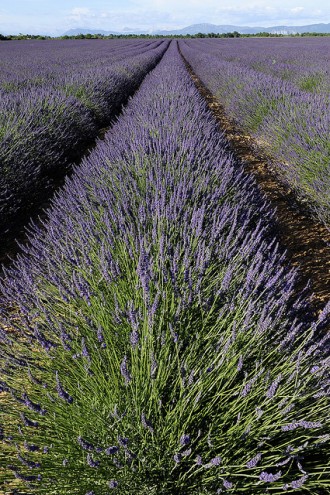 |
|
Lavender for sale to tourists |
Lavender fields |
The history of the origin of the variety Louis de Funes
Data on the date of breeding rose Louis de Fules vary. There are suggestions that it was bred in 1984 or 1987. The variety is produced by Meilland Internation - a company from France.
Diseases
Do you have dark spots on the shoots of the rose? It could be necrosis, learn how to save the plant
Bark necrosis on roses
Does the rose begin to wither and die for no apparent reason? It can be root rot, find out the measures of control and prevention
Root rot of roses
Girdling spots of brick and burgundy shades appear on the shoots of roses, find out why this happens
Infectious rose burn
Are there any build-ups and cracks on the rose? It could be cancer, read what to do next
Common rose crayfish
The plant is named after the famous French comedian actor Louis de Funes, who himself drew attention to this particular flower, walking through the rose garden, and called it wonderful, its shade reminded him of a sunny day in the south of France, where he had never been during the filming of the next film

Growing and care depending on the season
Louis de Funes feels most comfortable in good sunlight with a little shade during the period of maximum solar activity. The plant regularly tolerates shade, but in such conditions it will lose its chic and will be weaker.
The variety is not very whimsical, but it requires full care. You cannot leave him unattended. When the plant is actively growing and blooming, it needs to be watered frequently, avoiding drought.
Drying out of the soil on which the bush grows will lead to the fall of leaves and petals. The quality and beauty of flowers will deteriorate, the buds will become much smaller. Several times a month, the land around the bush must be loosened and provided with humus. This will keep the soil moist and not overheat.
During the period of active growth (spring), the plant should be fertilized with a nitrogen-based fertilizer. To prepare top dressing, take 10 liters of water, 10 g of urea and 20 g of nitrate. When the buds begin to grow, it's time to feed the rose with a concentrated mineral fertilizer with potassium and phosphorus.
In the spring, the bush is pruned, weak, thin, painful branches are removed. It is worth pruning the plant during sap flow. In winter, the rose needs to be rid of sick and dead shoots, the length should be shortened, the leaves should be completely removed. Processing is carried out at the end of October.
It is not necessary to cover the plant from freezing. To preserve it, it is enough to sprinkle young bushes with peat and cover with spruce branches. In order to avoid the appearance of powdery mildew, the rose must be treated with a fungicidal solution three times in the spring and summer.
Variants of using roses in landscape design
Louis de Funes looks good both in single form and in group landings
If you place the plant in the foreground of the lawn, it will surely attract the attention of passers-by and guests.
Pests
Bears have appeared in the garden, it is very dangerous for your flowers, learn how to drive away the pest
Medvedka
Several sources of foamy liquid are seen on the rose bush, this is a dangerous pest
Slobbering penny
Lilacs, cotoneaster, yellow acacia, euonymus, scumpia and other deciduous plants will look advantageous next to a honey rose. Among conifers, you can choose thuja, juniper, spruce.
In a color combination, it is best to combine a variety with a lilac, blue, blue tint. The rose is suitable for planting along paths, in parterres, ridges. The flower is suitable for cutting, it looks elegant in a vase and retains its freshness for a long time.
Useful tips for growing Louis de Funes
- When planting a rose, it is recommended to carefully compact the soil at the stem to eliminate all voids inside. This will allow the thin roots of the plant to better cling to the ground cover;
- It is better to water the rose abundantly, but not too often;
- From the middle of summer, you can not fertilize the rose, in August, for the last time, feed it with phosphorus for the winter;
- In the first year of a rose's life, you should not cut it off so that it blooms better. If desired, you can cut one flower, but capturing as little part of the stem as possible.
- Some gardeners advise not to pick the leaves from the rose for the winter, because it is from them that it receives its nutrition. After the nutrients in the leaves run out, she will dump them on her own.
Variety awards
Rose has high awards and one worthy title. The variety received the title of "Golden Rose", which it won at Monza in Italy and won the gold medal from Geneva.
Pros and cons of the variety
Advantages:
- Frost resistance,
- Shade tolerance,
- Good "immunity"
- Bright colors,
- Noble appearance,
- Longevity,
- Unpretentiousness.
Disadvantages:
- Discoloration,
- Sometimes the branches cannot stand large buds,
- Poorly tolerates the rainy season,
- Petals fall in the shade.
Plant care
Plants of this variety require constant care, regardless of their age and stage of development.
They require the implementation of the following agrotechnical measures:
- watering;
- pruning;
- top dressing;
- preparation for winter (shelter).
Watering
New Fashion hybrid tea rose requires abundant watering. For this you need to use warm water. Watering one bush usually requires 17 liters of water. Watering should be done once a week, if the weather is hot, then the number of waterings per week should be increased to two.
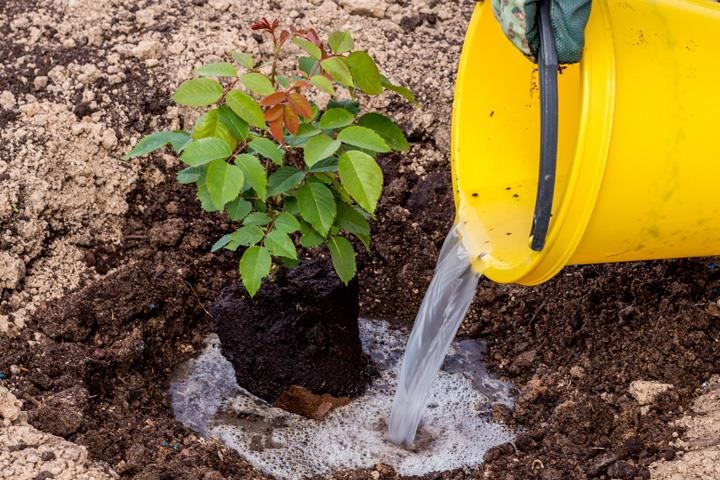
Watering the rose
Important! At the end of August, watering should be reduced, in the fall it should be stopped altogether
Fertilizer
Top dressing is done twice a year. In the spring, it is best to apply nitrogen fertilizers, in the fall, phosphorus and potash. These bushes also respond well to the introduction of organic matter.
Pruning
In the first year of the life of the bush, it should not be allowed to bloom. With the onset of August, you should leave 1-2 buds on each of the stems so that the fruits have time to ripen on them. Such a measure will provide the plant with an easier wintering and subsequent abundant flowering.
Pruning should be done in the spring with the appearance of the first buds. You need to cut it in such a way that six buds remain on each shoot. This option will allow not only to ensure abundant flowering, but also contribute to the correct formation of the bush. If the bushes are old, then it is better to leave 3-4 buds on each shoot.
For your information! During the summer, buds that have already bloomed are removed.
In the fall, you need to make sanitary pruning by removing dry and injured branches. Bushes need to be thinned out.
When cold weather sets in, rose bushes need to be covered. They are cut off. The hilling of the bush is carried out at its base. For this, garden soil or humus is used. The distances between the bushes are covered with spruce branches. They are also placed on the plants themselves.
How to plant and care for French roses
As already noted, the varieties of French roses are not whimsical plants, but they still need care so that they can delight with their magnificent flowering for many years. It lies in the fact that:
- It is worth planting varieties of the French rose in areas where diffused sunlight predominates, since the leaves under the scorching sun can get burned. And also the rich colors of rose petals lose their color and become pale;
- It is necessary to water the rose as the soil dries out, but do not forget that the ground near the bush must be loosened. So that oxygen can flow to the root system;
- It is necessary to feed the rose immediately upon planting, adding fertilizer directly to the dug hole. And the subsequent feeding is carried out in the spring, before bud break;
- It is better to plant French roses in the fall until mid-October, but you can also plant it in the spring. It directly depends on climatic conditions. If early frosts occur in the region, then the plant must be transplanted in the spring;
- In order for the roses for the next year to be able to please with large flowers, it is necessary not to cut off the faded buds, but to break off;
- Despite the fact that the bushes of French roses are frost-resistant, it is still necessary to cover them for the winter. To do this, you need to sprinkle the root system around the bush with fresh earth, and on top, you can add sawdust from coniferous trees.
Pruning is very important for growing French roses. It consists in:
- elimination of old pagons, thinning of shrubs. Thus, allowing the plant to give its strength to the growth of the bush and the creation of abundant flowering;
- In addition, the removal of old shoots allows the rose bush to rejuvenate, thereby prolonging its growth for a long time;
- Pruning of pagons should be carried out in the fall, before wintering. It is necessary to cut off any excess damaged pagons. And also, in the spring it is necessary to carry out a control check of the bush and cut off the pagons damaged during the winter.
Planting French roses on your personal plot makes it possible not only to create incredible landscapes, but also allow you to enjoy the most pleasant aromas of these amazing flowers.
... and other flowers
If you want to arrange a "French corner" in your garden, in addition to the listed flowers, be sure to plant annuals: space, asters, balsam, marigolds and begonias. From biennials, mallow, bells, pansies are suitable. And among perennials, the French would certainly recommend you Japanese anemone, gladioli, tulips, chrysanthemums, carnations, euphorbia, rudbeckia and thistle. And even more often arrange a holiday for yourself - make elegant bouquets, give them to your friends, decorate your home with flowers.
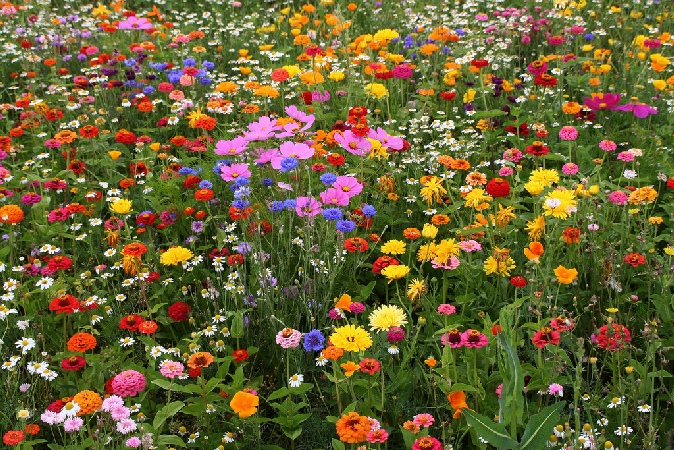 |
|
Flower fields in France |
Well, now our flower excursion in France has come to an end. Finally, I would like to note that the French are not used to saving on flowers. For the holidays, it is customary to give expensive bouquets, putting a certain meaning in this gift. Most often, flowers symbolize sincere feelings and heavenly life. These are the romantics and optimists, these Frenchmen.
Further care
Caring for Canadian Rose Connell is simple. The main thing is to follow the rules (water, loosen, mulch, apply top dressing in a timely manner):
- park rose Zh P Connel loves moisture, so you should not wait for the soil to dry out too much. It is necessary to ensure regular watering at the root. With the arrival of autumn, watering of roses stops;
- as soon as the layer of earth dries up after watering, it must be loosened up, mulched in order to delay the evaporation of moisture;
- Connell park rose is a powerful plant that holds its shape, so form-building pruning is not necessary. It is enough to remove broken and diseased shoots every spring;
- for the plant to develop fully, it is necessary to carry out regular feeding: apply nitrogen fertilizers in spring, potash and phosphorus fertilizers in summer;
- J.P. Connell does not need shelter, because it is a frost-resistant variety.You can sprinkle the bush with a small layer of soil during the autumn digging of the rose garden.
Breeding varieties
Gardeners who have grown a bush of the Canadian variety in their garden seek to propagate it using cuttings.
Propagation by cuttings
Detailed instructions for this process are as follows:
- In July, it is necessary to cut cuttings from strong, healthy shoots. There should be no flowering buds on the shoot.
- The shoot is cut under an oblique cut into pieces 25-30 cm long.
- On each cutting, at the base (on one side), the bark is removed by about a centimeter and all leaves are removed, except for the top two.
- In order for the seedlings to take root faster, they need to be kept in a root formation stimulator.
- In the southern regions, shoots can be planted directly into the ground, although gardeners believe that it is better to plant the cutting in a flowerpot and cover it with another vessel.
- The planting material is placed in the shade. He needs regular watering.
Important! By the fall, shoots take root. Vases with new copies must be moved to the basement.
If a self-rooted stalk is planted in open ground, it must be covered for the winter.
The Canadian rose J. P. Connell is an excellent replacement for other capricious varieties. Its advantages are unpretentiousness and resistance to severe frosts (it is not for nothing that it belongs to the Canadian type of roses). Even if there is minimal care for the bush, it will delight you with its incessant flowering throughout the summer.
The main diseases, pests and ways to control them
The main diseases of French roses include:
- Mealy rose. For treatment, you need to spray the bush with a 2.5% solution of copper and soap (0.5 kg of vitriol, 1 kg of soap per 10 liters of water), 2-3% solution of Bordeaux liquid, 30% iron vitriol, nettle broth. You need to process the bush on the same day as the solution was prepared.
- Black spot. All diseased areas should be removed and burned. Spray the bush with 1% Bordeaux liquid or copper-soapy solution, 0.1% foundation and nettle or horsetail decoction.
- Rust. First, you should cut off all diseased parts of the plant. During the summer season, periodically spray with a 2% solution of Bordeaux liquid and soap-copper solution, nettle or wormwood broth.
- Gray rot. To prevent the manifestation of the disease, in a rainy season, the bush needs to be fed with fertilizers that contain manganese.
The most common pests of roses and how to deal with them:
- Spider mite. After its appearance, you need to remove the fallen leaves and burn it. Treat the bush three times with an interval of 5 days to a week with an insecticide of systemic and contact action.
- Green rose aphid. Insecticides (aktara, actellik), soap solution, tincture of tobacco, decoction of garlic or pepper will also help here. You need to process it 2-3 times per season with a break for 3 days.
- Rose leaflet. To eliminate it, you need to collect all the caterpillars and destroy, then treat the bush with garlic or onion broth. Bacterial preparations will also help.
- Rose-colored scale insect. You can remove these pests with the help of actara, fufanon, soap-garlic or soap-kerosene infusion. You need to process it three times a season with a break of 7-10 days.
- Medvedka. Only preventive measures will help here: plow the soil in early spring and autumn, and deeply loosen the soil during the growing season. In a dry season, water the soil with infusion of chicken droppings. You can also plant marigolds along the border of the site, since their smell scares off the pest.
There is nothing difficult in growing French roses. The main thing is to choose a variety suitable for the region, plant it correctly and provide decent care. As a result, rose bushes will reward with abundant and lush flowering.
vote
Article Rating
Burgundy
Burgundy or Bourgogne in eastern France is a region where red and white wines are equally important. Burgundy is more terroir-oriented than any other wine region in France, so the region is divided into more appellations than any other French region.The best wines from the heart of Burgundy in the Côte d'Or (it is divided into Cote de Nuits and Cote de Beaune) are quite expensive, starting at € 30 per bottle and easily going up to € 100.
Burgundy has four main parts:
- Cote de Nuits (from Marsanne-la-Cote to Nuits-Saint-Georges)
- Cote de Beaune (from the north from Beaune to Santenay)
- Cote chalonnaise
- Maconnais
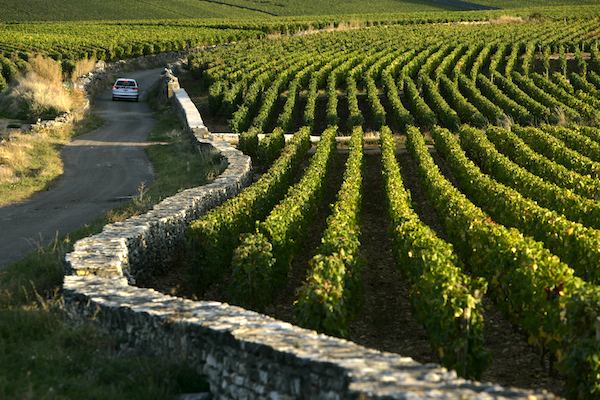
Two parts of Burgundy that are sometimes considered separate regions:
- Beaujolais in the south, close to the Rhone Valley region, where mainly fruit-style red wines are produced, which are usually consumed young. Beaujolais Nouveau is the only wine that can be legally consumed in the year of its production (end of the third week of November)
- Chablis, halfway between the Côte d'Or and Paris, where white wines are produced on chalky soil, giving a fresher and colder style than the rest of Burgundy.
There are two main grape varieties used in Burgundy - Chardonnay for white wines and Pinot Noir for reds. White wines are also sometimes made from Aligote, sometimes other grape varieties are found.
- Burgundy wines
- Burgundy wines Grand Cru
- La Route des Grand Crus
- Beaujolais
- Chablis
-
Cote d'Or
- Côte de Nuits
- Côte de Beaune
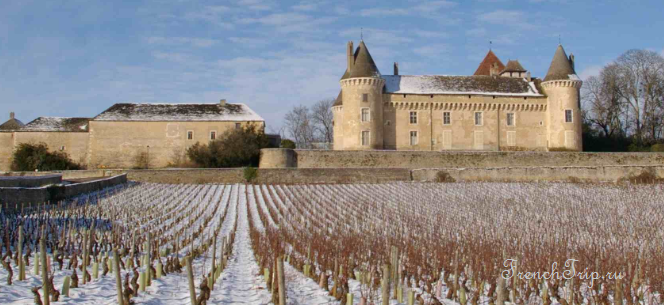
Alsace
Alsace - This small region is famous for its great white wines, although reds, rosés, sparkling (fine Crémant d'Alsace, close to classic champagne) and sweet wines are also produced here. Alsace is located in eastern France on the Illus River and borders Germany, a country with which it shares many grape varieties and a long tradition of varietal labeling. Grapes grown in Alsace include Riesling, Gewurztraminer, Pinot Gris, Pinot Blanc, Pinot Noir and Muscat.
- Alsace wines
- Crémant d'Alsace
- The best wines of Crémant d'Alsace
- Wines of Turkheim
- Alsace Wine Route
